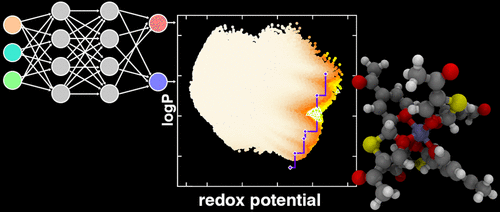当前位置:
X-MOL 学术
›
ACS Cent. Sci.
›
论文详情
Our official English website, www.x-mol.net, welcomes your feedback! (Note: you will need to create a separate account there.)
Accurate Multiobjective Design in a Space of Millions of Transition Metal Complexes with Neural-Network-Driven Efficient Global Optimization.
ACS Central Science ( IF 18.2 ) Pub Date : 2020-03-11 , DOI: 10.1021/acscentsci.0c00026 Jon Paul Janet 1 , Sahasrajit Ramesh 1 , Chenru Duan 1, 2 , Heather J Kulik 1
ACS Central Science ( IF 18.2 ) Pub Date : 2020-03-11 , DOI: 10.1021/acscentsci.0c00026 Jon Paul Janet 1 , Sahasrajit Ramesh 1 , Chenru Duan 1, 2 , Heather J Kulik 1
Affiliation

|
The accelerated discovery of materials for real world applications requires the achievement of multiple design objectives. The multidimensional nature of the search necessitates exploration of multimillion compound libraries over which even density functional theory (DFT) screening is intractable. Machine learning (e.g., artificial neural network, ANN, or Gaussian process, GP) models for this task are limited by training data availability and predictive uncertainty quantification (UQ). We overcome such limitations by using efficient global optimization (EGO) with the multidimensional expected improvement (EI) criterion. EGO balances exploitation of a trained model with acquisition of new DFT data at the Pareto front, the region of chemical space that contains the optimal trade-off between multiple design criteria. We demonstrate this approach for the simultaneous optimization of redox potential and solubility in candidate M(II)/M(III) redox couples for redox flow batteries from a space of 2.8 M transition metal complexes designed for stability in practical redox flow battery (RFB) applications. We show that a multitask ANN with latent-distance-based UQ surpasses the generalization performance of a GP in this space. With this approach, ANN prediction and EI scoring of the full space are achieved in minutes. Starting from ca. 100 representative points, EGO improves both properties by over 3 standard deviations in only five generations. Analysis of lookahead errors confirms rapid ANN model improvement during the EGO process, achieving suitable accuracy for predictive design in the space of transition metal complexes. The ANN-driven EI approach achieves at least 500-fold acceleration over random search, identifying a Pareto-optimal design in around 5 weeks instead of 50 years.
中文翻译:

数以百万计的过渡金属配合物空间中的精确多目标设计,具有神经网络驱动的高效全局优化。
加快在现实世界中应用材料的发现,需要实现多个设计目标。搜索的多维性质要求探索数百万个化合物库,在这些化合物库上,甚至密度泛函理论(DFT)筛选都难以解决。通过训练数据可用性和预测性不确定性量化(UQ)来限制用于此任务的机器学习(例如,人工神经网络,ANN或高斯过程,GP)模型。我们通过将有效的全局优化(EGO)与多维预期改进(EI)准则结合使用来克服此类限制。EGO在Pareto前沿(化学空间区域包含多个设计标准之间的最佳权衡)中获取新的DFT数据,从而平衡了对经过训练的模型的利用。我们展示了用于同时优化氧化还原液流电池候选M(II)/ M(III)氧化还原对中氧化还原电势和溶解度的这种方法,该空间设计用于在实际氧化还原液流电池(RFB)中稳定的2.8 M过渡金属配合物应用程序。我们表明,基于潜在距离的UQ的多任务ANN超过了该空间中GP的泛化性能。使用这种方法,可以在几分钟内完成整个空间的ANN预测和EI评分。从ca开始。100个代表点,EGO仅在5代内就通过3个以上的标准偏差改善了这两种属性。对超前误差的分析确认了EGO过程中ANN模型的快速改进,在过渡金属配合物的空间中实现了预测设计的合适精度。
更新日期:2020-04-23
中文翻译:

数以百万计的过渡金属配合物空间中的精确多目标设计,具有神经网络驱动的高效全局优化。
加快在现实世界中应用材料的发现,需要实现多个设计目标。搜索的多维性质要求探索数百万个化合物库,在这些化合物库上,甚至密度泛函理论(DFT)筛选都难以解决。通过训练数据可用性和预测性不确定性量化(UQ)来限制用于此任务的机器学习(例如,人工神经网络,ANN或高斯过程,GP)模型。我们通过将有效的全局优化(EGO)与多维预期改进(EI)准则结合使用来克服此类限制。EGO在Pareto前沿(化学空间区域包含多个设计标准之间的最佳权衡)中获取新的DFT数据,从而平衡了对经过训练的模型的利用。我们展示了用于同时优化氧化还原液流电池候选M(II)/ M(III)氧化还原对中氧化还原电势和溶解度的这种方法,该空间设计用于在实际氧化还原液流电池(RFB)中稳定的2.8 M过渡金属配合物应用程序。我们表明,基于潜在距离的UQ的多任务ANN超过了该空间中GP的泛化性能。使用这种方法,可以在几分钟内完成整个空间的ANN预测和EI评分。从ca开始。100个代表点,EGO仅在5代内就通过3个以上的标准偏差改善了这两种属性。对超前误差的分析确认了EGO过程中ANN模型的快速改进,在过渡金属配合物的空间中实现了预测设计的合适精度。



























 京公网安备 11010802027423号
京公网安备 11010802027423号